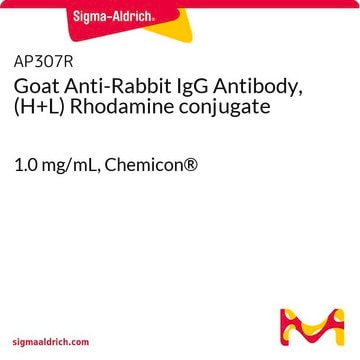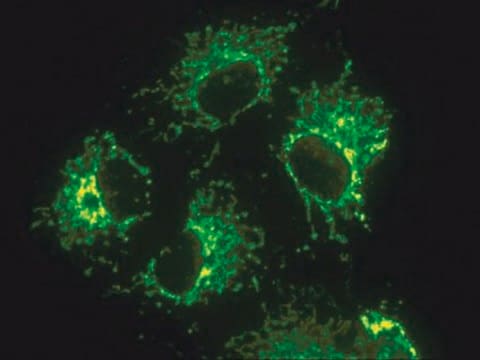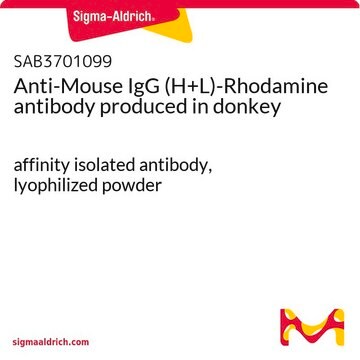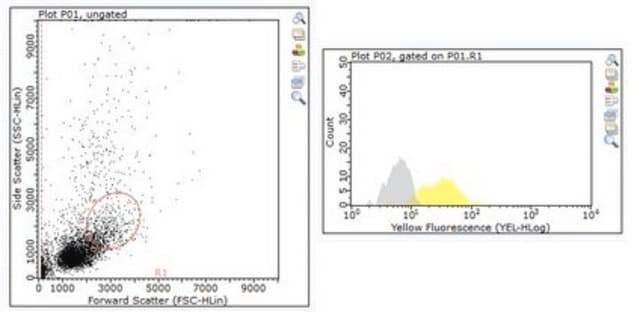AP192R
Donkey Anti-Mouse IgG Antibody, Rhodamine conjugate, Species Adsorbed
Chemicon®, from donkey
Sign Into View Organizational & Contract Pricing
All Photos(1)
About This Item
UNSPSC Code:
12352203
eCl@ss:
32160702
NACRES:
NA.46
Recommended Products
biological source
donkey
Quality Level
conjugate
TRITC conjugate
rhodamine conjugate
antibody form
affinity purified immunoglobulin
antibody product type
secondary antibodies
clone
polyclonal
species reactivity
mouse
manufacturer/tradename
Chemicon®
technique(s)
immunofluorescence: suitable
shipped in
wet ice
target post-translational modification
unmodified
General description
Immunoglobulin G (IgG), is one of the most abundant proteins in human serum with normal levels between 8-17 mg/mL in adult blood. IgG is important for our defence against microorganisms and the molecules are produced by B lymphocytes as a part of our adaptive immune response. The IgG molecule has two separate functions; to bind to the pathogen that elicited the response and to recruit other cells and molecules to destroy the antigen. The variability of the IgG pool is generated by somatic recombination and the number of specificities in an individual at a given time point is estimated to be 1011 variants.
Specificity
Mouse IgG
WAVELENGTH:
Absorption peak = 550 nm, Emission peak = 570 nm.
WAVELENGTH:
Absorption peak = 550 nm, Emission peak = 570 nm.
Application
Donkey anti-Mouse IgG Antibody, Rhodamine conjugate, Species Adsorbed is an antibody against Donkey Mouse IgG for use in IF.
Research Category
Secondary & Control Antibodies
Secondary & Control Antibodies
Research Sub Category
Secondary Antibodies Adsorbed for Dual Labeling
Secondary Antibodies Adsorbed for Dual Labeling
Suggested dilution for most applications: 1:50-1:200
Optimal working dilutions must be determined by end user.
Optimal working dilutions must be determined by end user.
Physical form
Lyophilized. Buffer = 0.01 M Sodium Phosphate, 0.25 M NaCl, pH 7.6 with 15 mg/mL BSA, and 0.05% sodium azide.
RECONSTITUTION:
Reconstitute with 500 μL of sterile distilled water.
RHODAMINE/PROTEIN:
Approximately 0.40 (A550/A280).
RECONSTITUTION:
Reconstitute with 500 μL of sterile distilled water.
RHODAMINE/PROTEIN:
Approximately 0.40 (A550/A280).
Storage and Stability
Maintain lyophilized product at 2-8°C for up to 12 months. After reconstitution the product is stable for several weeks at 2-8°C as an undiluted liquid. For extended storage after reconstitution, add an equal volume of glycerol to make a final concentration of 50% glycerol followed by storage at -20°C in undiluted aliquots for up to 12 months. Please note the concentration of protein (and buffer salts) will decrease to one-half of the original after the addition of glycerol. Avoid repeated freeze/thaw cycles.
Legal Information
CHEMICON is a registered trademark of Merck KGaA, Darmstadt, Germany
Disclaimer
Unless otherwise stated in our catalog or other company documentation accompanying the product(s), our products are intended for research use only and are not to be used for any other purpose, which includes but is not limited to, unauthorized commercial uses, in vitro diagnostic uses, ex vivo or in vivo therapeutic uses or any type of consumption or application to humans or animals.
Not finding the right product?
Try our Product Selector Tool.
hcodes
pcodes
Hazard Classifications
Aquatic Chronic 3
Storage Class
11 - Combustible Solids
wgk_germany
WGK 3
Certificates of Analysis (COA)
Search for Certificates of Analysis (COA) by entering the products Lot/Batch Number. Lot and Batch Numbers can be found on a product’s label following the words ‘Lot’ or ‘Batch’.
Already Own This Product?
Find documentation for the products that you have recently purchased in the Document Library.
Willian Lazarini-Lopes et al.
Biomedicines, 10(2) (2022-02-26)
Epilepsies are neurological disorders characterized by chronic seizures and their related neuropsychiatric comorbidities, such as anxiety. The Transient Receptor Potential Vanilloid type-1 (TRPV1) channel has been implicated in the modulation of seizures and anxiety-like behaviors in preclinical models. Here, we
RebL1 is required for macronuclear structure stability and gametogenesis in Tetrahymena thermophila.
Huijuan Hao et al.
Marine life science & technology, 6(2), 183-197 (2024-06-03)
Histone modification and nucleosome assembly play important roles in chromatin-related processes. Histone chaperones form different complexes and coordinate histone transportation and assembly. Various histone chaperone complexes have been identified in different organisms. The ciliate protozoa (ciliates) have various chromatin structures
Hirohumi Suzuki et al.
Anatomia, histologia, embryologia, 48(5), 415-420 (2019-06-27)
We examined the distribution of the orexin-like peptides in the pituitary and median eminence of the flat-tailed house gecko (Hemidactylus platyurus) using immunohistochemistry. Orexin-B-like, but not orexin-A-like, immunoreactivity was detected in the pituitary, specifically in the pars intermedia, and these
An appraisal of intermediate filament expression in adult and developing pancreas: vimentin is expressed in alpha cells of rat and mouse embryos.
Di Bella, A; Regoli, M; Nicoletti, C; Ermini, L; Fonzi, L; Bertelli, E
The journal of histochemistry and cytochemistry : official journal of the Histochemistry Society null
Shawn H Tsai et al.
Experimental and therapeutic medicine, 14(5), 4853-4861 (2017-12-05)
A previous study by our group showed that a 44-amino-acid fragment of pigment epithelium-derived factor (PEDF) facilitated corneal epithelial wound healing. In the present study this fragment was shortened to obtain peptides of 18, 20 and 29 amino acids in
Our team of scientists has experience in all areas of research including Life Science, Material Science, Chemical Synthesis, Chromatography, Analytical and many others.
Contact Technical Service








